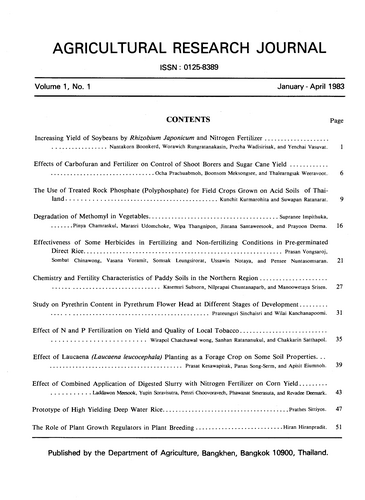The Use of Treated Rock Phosphate (Polyphosphate) for Field Crops Grown on Acid Soils of Thailand
Abstract
A locally manufactured polyphosphate was tested on corn, soybean , mungbean and paddy rice grown on acid soils with. low P availability for several consecutive periods in field grown condition during 1978 - 1981. The material had the following analysis : 12% available P2O5, 25.4% total P2O5, 14% S, 18% Ca, 2.4% F. Five treatments , each replicated 4 times, were assigned to compare the effects of the material against standard phosphate fertilizer (DSP & TSP). Treatments were : 1) chece, 2) standard phosphate-banded, 3) polyphosphatebanded, 4) polyphosphate-broadcasted, and 5) polyphosphate-broadcasted at 1/2 rate. All treatments received optimal N and K applications for each crop grown in each season. Phosphate materials were applied only once in the initeal year and cropping was repeated to check the residual effects of the material. Therewas no correction of soil acidity by liming at all test sites.
The results of the sutdy revealed that the effects of polyphosphate on growth and yields of corn and soybean during the first year were comparable to the standard P-source in almost every soil sites tested. In areas where soil acidity was high (pH below 5.0) polyphosphate producted better growth and yields of thecrops than the standard P-source. In these acid soil ares, repeated cropping showed that the residual effects polyphosphate were significantly greater and lated longer than the standard P-source. In acid soils with high P-fixing capacity, broadcast application of this material was superior to band application. This result was observed in the first year of the first cropping. However, the result could be reversed in sosme situations when soils were acid but exhibited little P-fixing capacity. In general, band-treatment showed greater residual availability of P as it produced better yields than broadcast-treatment in the 2nd , 3rd and 4the crops. This might be due to the fact that the amount of polyphosphate material applied in band had been consumed by crops and subjected to soil reaction in the first year to a lesser extent than that of broadcast material. It was true that, after the first harvest, soil preparation for the second crop broke loose the band of previously applied fertillizer and such a "banding effect" would last only in the growing period of the first crop. the remaining available amount of the previously banded material worul then be undoubtedly greater than that of the previously brodcasted material. Half-rate application of polyphosphate slightly producted less growth and yield of the crops but tended to be more economical than full-rate application. In this study, the residual effects of polyphophate on subsequent crops were noticeable up to 3 years. The effect tended to diminish by the 4th year whereas that of the standard fertilizer had diminished after the 2nd year of cropping.
Downloads
Published
How to Cite
Issue
Section
License
Thai Agricultural Research Journal



